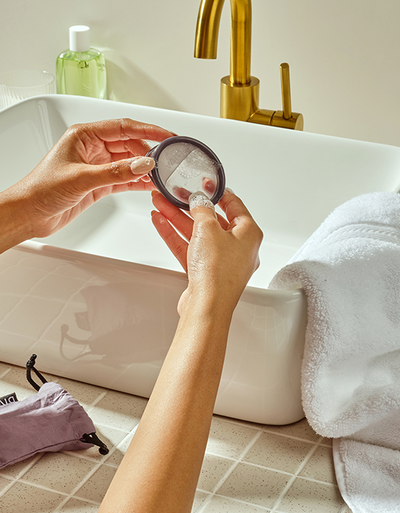In this article /
Il est fortement recommandé de stériliser vos produits menstruels entre les cycles. Nos produits menstruels réutilisables sont fabriqués à 100 % à partir de silicone de qualité médicale qui résiste aux bactéries lorsqu’ils sont nettoyés et entretenus correctement. Alors, lorsque vous nettoyez votre coupe, un stérilisateur de coupe menstruelle UV devrait-il être votre choix n°1 ?
Risques de stérilisation incomplète
Une stérilisation incomplète des dispositifs menstruels peut entraîner une croissance bactérienne. Cela peut provoquer des infections, telles que vaginose bactérienne (BV) ou syndrome de choc toxique (SCT) .
De plus, si les coupes et disques menstruels ne sont pas correctement nettoyés et stockés, cela peut entraîner des odeurs désagréables, une décoloration et une détérioration progressive.
Qu’est-ce que la stérilisation UV pour les coupes menstruelles ?
La stérilisation UV est la dernière tendance en matière de nettoyage rapide et portable des coupes menstruelles. Stérilisation UV utilise la lumière ultraviolette (UV) pour tuer les bactéries, virus et autres micro-organismes. Il est utilisé pour stériliser une grande variété de surfaces et d’objets et est le plus souvent utilisé pour désinfecter des technologies comme votre téléphone ou vos écouteurs.
Mais ces appareils de stérilisation UV fonctionnent-ils pour les coupes et disques menstruels ? Ça dépend. L'efficacité des stérilisateurs UV portables dépend de l'appareil lui-même, de la durée pendant laquelle la tasse est exposée à la lumière UV et de la puissance de la lampe UV-C. Certains appareils peuvent être conçus pour stériliser la coupe en quelques minutes, tandis que d'autres peuvent prendre un peu plus de temps.
Comme toute autre méthode de stérilisation, il est important de bien nettoyer et rincer votre coupe menstruelle avant de la stériliser avec un stérilisateur UV portable, car cette méthode à elle seule n'éliminera pas la saleté. taches ou tout liquide menstruel antérieur.
Quelle est l’efficacité de la stérilisation UV ?
Avant de mettre la main sur un stérilisateur UV pour nettoyer votre DivaCup, méfiez-vous des limitations. Selon le Dr Lother Lilge, scientifique principal au Département de biophysique médicale de l'Université de Toronto et au Centre de recherche du Réseau universitaire de santé, la stérilisation UV des cupules en silicone de qualité médicale présente certaines lacunes potentielles.
La stérilisation UV-C est principalement utilisée sur des surfaces planes. La courbure de la DivaCup ou du Diva Disc présente-t-elle un défi ? Lilge a reconnu que cela pourrait affecter l'efficacité des stérilisateurs UV.
De nombreux stérilisateurs de gobelets UV-C sur le marché sont conçus comme des récipients dotés de lumières UV-C sur 1 ou 2 surfaces et d'un couvercle à fermer une fois que le gobelet est à l'intérieur. Le récipient lui-même est généralement blanc et réfléchissant et, dans de nombreux cas, fabriqué en silicone qui n'absorbe pas les UV-C, ce qui devrait permettre à la lumière de se refléter dans les nombreuses courbes de la tasse.
Bien que cela soit utile, il n'existe aucune donnée concluante indiquant s'il s'agit d'un contact direct suffisant avec la lumière UV-C pour tuer efficacement les bactéries, virus et autres micro-organismes nocifs sur votre coupe ou disque menstruel.

L’état de votre coupe menstruelle modifiera l’efficacité d’un stérilisateur de coupe menstruelle UV.
État de la tasse
L’état de votre tasse affectera également la profondeur de son nettoyage. Par exemple, s’il existe des fissures micro (moins de 1 micromètre de longueur, non visibles à l’œil nu) ou méso (taille d’un micromètre à un millimètre, presque invisible à l’œil nu), il est possible que des microbes et des virus pénètrent. en dessous de la surface.
Lilge déclare : « Si la surface est compromise par des microfissures suffisamment grandes pour que les microbes puissent y pénétrer, les UV-C seront absorbés dans les premiers microns du silicium et les microbes incrustés plus profondément dans un matériau poreux ne pourront pas être ciblés. »
Les autres techniques de stérilisation des tasses, comme les récipients cuits à la vapeur au micro-ondes, les cuiseurs à vapeur portables ou l'ébullition sur une cuisinière, ne sont pas affectées par ces détériorations. « Les micro-ondes pénétreront plus profondément dans le matériau, tout comme la chaleur issue de l’ébullition. La clé ici est donc l’intégrité de la surface à l’échelle du micron », explique Lilge.
Ces crevasses pourraient également créer des ombres sur la surface de la coupe menstruelle, ajoute Lilge, empêchant ainsi un contact complet de la lumière UV-C avec chaque centimètre de la surface de la coupe.
Autres facteurs à considérer
La stérilisation UV-C a également des conséquences potentielles à long terme, car l'appareil lui-même peut potentiellement accélérer la dégradation de votre cupule ou disque en silicone.
"La lumière UV-C peut initier la rupture des liaisons peptidiques, ce qui peut créer des radicaux, dégradant davantage le silicium", prévient Lilge. "Je ne peux pas dire à quelle vitesse la dégradation du matériau sera, mais elle s'accumulera au fil des cycles de stérilisation répétés."
Cela signifie que si vous comptez sur la stérilisation UV pour nettoyer votre tasse, non seulement l'efficacité de la stérilisation est inconnue, mais la source de lumière elle-même peut détruire votre tasse plus rapidement avec le temps.
Conclusion
Bien que la technologie soit impressionnante, l’utilisation des stérilisateurs UV-C présente potentiellement des problèmes actuels et futurs. La meilleure solution consiste toujours à adhérer à un processus de nettoyage en deux étapes.
Que vous choisissiez des cuiseurs à vapeur ou que vous fassiez bouillir votre tasse, associez-la toujours à un nettoyage de routine avec un nettoyant spécialement formulé, comme DivaWash et rincez abondamment à l'eau tiède. DivaWash a été conçu pour protéger vos produits Diva. Lorsqu'elle est associée périodiquement à une technique de stérilisation plus avancée, votre DivaCup ou Diva Disc devrait durer jusqu'à plusieurs années.











